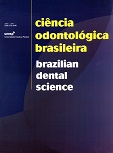Avaliação da capacidade de selamento marginal do esmalte e da dentina utilizando diferentes sistemas adesivos e tratamentos superficiais
DOI:
https://doi.org/10.14295/bds.2009.v12i4.643Abstract
Para analisar a capacidade de selamento marginal de três sistemas adesivos com formas diferentes de tratamentos superficiais foram selecionados 45 incisivos bovinos, íntegros e recém extraídos. Cada dente recebeu um preparo cavitário de Classe V no limite cemento-esmalte. Os preparos foram padronizados nas seguintes dimensões: 1,5mm de profundidade e 2,0mm de diâmetro. A margem incisal foi deixada em esmalte e a margem gengival localizada abaixo da junção cemento-esmalte. Os dentes foram divididos em três grupos com 15 dentes cada. No grupo I foi utilizado o Adesivo XP Bond com dentina deixada úmida após condicionamento ácido. No grupo II o sistema utilizado foi o Adper SE Plus e no grupo lll foi aplicado o sistema adesivo Adper Single-Bond 2. Em seguida, os dentes foram restaurados com resina composta nanoparticulada Filtek – Z350 (3M). Após ciclagem térmica (300 ciclos), os dentes foram imersos em solução aquosa de Azul de Metileno 2% por um período de 3 horas. Para avaliação do grau de penetração do corante foram determinados escores de 0 a 3. A análise da penetração do corante foi realizada através de microscopia óptica e aplicado o teste Kruskal-Wallis ao nível de significância de 5%. Em esmalte e dentina houve diferença entre os grupos, porém a infiltração foi maior na dentina que em esmalte, com exceção do sistema autocondicionante.
Downloads
Downloads
Published
How to Cite
Issue
Section
License
Brazilian Dental Science uses the Creative Commons (CC-BY 4.0) license, thus preserving the integrity of articles in an open access environment. The journal allows the author to retain publishing rights without restrictions.
=================




























